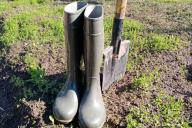Late autumn is the ideal time to feed currants, which lays the foundation for the future harvest.
Correctly selected fertilizers will help the bushes survive the winter and gain strength for spring awakening.
Experienced gardeners know that November feeding is the key to the health and productivity of berry bushes.
An expert of the online publication "BelNovosti", agronomist and landscape designer Anastasia Kovrizhnykh shared important recommendations.
The Importance of Autumn Fertilization
Autumn feeding of currants plays an important role in the life cycle of the plant. During this period, the bushes prepare for winter dormancy, accumulating nutrients in the roots and branches.

Fertilizing in November helps strengthen the immunity of plants, increases their frost resistance and provides a reserve of strength for spring awakening.
Correctly selected nutrients help currants form strong buds, which will develop into juicy and large berries in the following season.
Organic fertilizers for currants
Compost is considered one of the best organic fertilizers for currants. It enriches the soil with humus, improves its structure and provides plants with a complex of essential nutrients.
To add compost, shallow furrows are dug around the bush, into which the fertilizer is placed, after which it is dug into the soil.
Rotted manure is an excellent source of nitrogen, potassium and phosphorus. It is applied at a rate of 4-5 kg per adult bush.
The manure is evenly distributed around the plant and incorporated into the top layer of soil. Using fresh manure is not recommended, as it can cause root burns and encourage weed growth.
Peat enriches the soil with organic matter and improves its structure. Its use is especially relevant on heavy clay soils. Peat is added to the currant tree trunks in a 2-3 cm layer, lightly burying it in the soil.
Mineral fertilizers
Phosphorus fertilizers are especially important for autumn feeding of currants. They promote the development of the root system and increase the winter hardiness of plants. Superphosphate is applied at a rate of 30-40 g per square meter of the trunk circle.
Potassium fertilizers help currants prepare for winter, increasing resistance to low temperatures and diseases. Potassium sulfate or potassium magnesium sulfate is used in a dosage of 20-25 g per square meter.
Complex mineral fertilizers, developed specifically for berry crops, contain a balanced set of macro- and microelements. Their use simplifies the feeding process and provides plants with all the necessary substances.
Features of fertilization
When applying fertilizer in November, several important factors should be taken into account. Fertilizing is carried out in dry weather, when the air temperature has not yet dropped below zero.
Fertilizers are distributed evenly around the bush, leaving 20-30 cm from the trunk to avoid burning the bark.
After applying mineral fertilizers, the soil must be loosened and watered.
The procedure is considered complete after mulching the tree trunk circle with peat, compost or rotted sawdust. The mulch layer protects the roots from freezing and retains moisture in the soil.
The dosage of fertilizers depends on the age of the bush and the fertility of the soil. Young plants need fewer nutrients than adult fruit-bearing bushes. On poor soils, the dosage of fertilizers is increased, and on fertile soils, it is decreased.
Safety rules for feeding
When working with fertilizers, it is necessary to take precautions.
Use gloves and safety glasses to avoid contact with skin and eyes. Wash hands and tools thoroughly after applying fertilizer.
Do not exceed recommended dosages, as too much of a nutrient can be just as harmful to plants as too little.
Avoid applying fertilizer to frozen or waterlogged soil, as under these conditions it is not absorbed by plants and may wash out into groundwater.
Alternative methods of feeding
Green manures, or green manures, are an excellent alternative to traditional fertilizers. They are sown between the rows of currants at the end of summer. By November, the green manures form a green mass, which is dug into the soil. Mustard, phacelia or rye enrich the soil with organic matter and improve its structure.
Wood ash contains potassium, calcium and microelements necessary for currants. It is added in the fall at the rate of 100-150 g per square meter of the trunk circle. Ash not only nourishes plants, but also reduces soil acidity.
Nettle infusion is an effective organic fertilizer, rich in nitrogen and microelements. It is prepared by infusing crushed nettles in water for a week, then diluting and using it to water currants.









